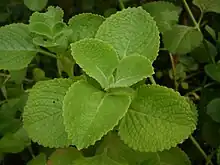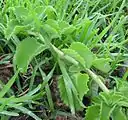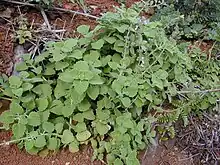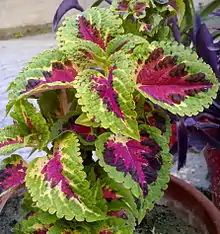Coleus
Coleus (/ˈkəʊ.li.əs/, kow-lee-uhs) is a genus of annual or perennial herbs or shrubs, sometimes succulent, sometimes with a fleshy or tuberous rootstock, found in the Afro-Eurasia tropics and subtropics.
| Coleus | |
|---|---|
 | |
| Coleus amboinicus (syn. Plectranthus amboinicus) | |
| Scientific classification | |
| Kingdom: | Plantae |
| Clade: | Tracheophytes |
| Clade: | Angiosperms |
| Clade: | Eudicots |
| Clade: | Asterids |
| Order: | Lamiales |
| Family: | Lamiaceae |
| Tribe: | Ocimeae |
| Genus: | Coleus Lour.[1] |
| Synonyms[1] | |
| |
The relationship among the genera Coleus, Solenostemon and Plectranthus has been confused. Coleus and Solenostemon were sunk into Plectranthus, but recent phylogenetic analysis found Plectranthus to be paraphyletic with respect to other related genera in the subtribe Plectranthinae. The most recent taxonomic treatment of the genus resurrected Coleus, and 212 names were changed from combinations in Plectranthus, Pycnostachys and Anisochilus. Equilabium was segregated from Plectranthus, after phylogenetic studies supported its recognition as a phylogenetically distinct genus.[2] Common names for Coleus include spurflower, flybush, hedgehog flower and hullwort.
Coleus are cultivated as ornamental plants, particularly Coleus scutellarioides (syns. Coleus blumei, Plectranthus scutellarioides), which is popular as a garden plant for its brightly colored foliage.
Other species that produce root tubers are cultivated for food, including Coleus esculentus, Coleus rotundifolius and Coleus maculosus subsp. edulis.
Taxonomy
The genus Coleus was first described by João de Loureiro in 1790. Using morphological characters as a guide, it was distinguished from Plectranthus (first described by Charles L'Héritier in 1788) by having its four stamens fused together rather than free to the base. In 1962, J.K. Morton noted that fused stamens were more widespread than previously thought, and accordingly merged Coleus into Plectranthus, while maintaining Solenostemon and some other genera as distinct.[3] Most sources followed Morton in submerging Coleus; some kept Solenostemon distinct, although others submerged it into Plectranthus along with Coleus.[2]
A preliminary study of the tribe Ocimeae in 2004 showed that the subtribe Plectranthinae was monophyletic, with two main clades: one containing the type species of Coleus and including Solenostemon, the other containing the type species of Plectranthus along with some other genera, so that Plectranthus when broadly defined was not monophyletic. A more detailed study in 2018 reached similar conclusions, and suggested that Coleus (including Solenostemon) should be recognized again, Plectranthus more narrowly defined, and a new genus, Equilabium erected for a clade of former Plectranthus species mainly from tropical Africa. The many new binomial combinations needed to implement this approach were provided in 2019.[2]
Phylogeny
Paton et al. in 2019 published a summary cladogram for the subtribe Plectranthinae,[2] based on a study in 2018.[4] In the version below, the three genera accepted by Paton et al. that formed part of Plectranthus s.l. are highlighted.
| Tribe Ocimeae |
| ||||||||||||||||||||||||||||||||||||||||||
Species
Paton et al. (2019) listed 294 species of Coleus, many transferred from Plectranthus.[2] As of October 2022, Plants of the World Online listed 301.[1] Species include:[2][1]
- Coleus amboinicus, syn. Plectranthus amboinicus
- Coleus argentatus
- Coleus australis
- Coleus barbatus, syn. Plectranthus barbatus
- Coleus caninus, syn. Plectranthus caninus
- Coleus cataractarum
- Coleus comosus, syn. Plectranthus ornatus (sold as "Coleus canina" or "scaredy cat plant")
- Coleus cremnus
- Coleus dissitiflorus
- Coleus esculentus, syn. Plectranthus esculentus
- Coleus fredericii, syn. Plectranthus welwitschii
- Coleus graveolens
- Coleus maculosus
- Coleus neochilus
- Coleus rotundifolius, syn. Plectranthus rotundifolius
- Coleus scutellarioides, syns Coleus blumei, Plectranthus scutellarioides
- Coleus socotranus, syn. Plectranthus socotranus
- Coleus unguentarius, syn. Plectranthus unguentarius
Image gallery



 Cultivars in Monsoon, West Bengal, India
Cultivars in Monsoon, West Bengal, India
Citations
- "Coleus Lour". Plants of the World Online. Royal Botanic Gardens, Kew. Retrieved 7 October 2022.
- Paton, Alan J.; Mwanyambo, Montfort; Govaerts, Rafaël H.A.; Smitha, Kokkaraniyil; Suddee, Somran; Phillipson, Peter B.; Wilson, Trevor C.; Forster, Paul I. & Culham, Alastair (2019). "Nomenclatural changes in Coleus and Plectranthus (Lamiaceae): a tale of more than two genera". PhytoKeys (129): 1–158. doi:10.3897/phytokeys.129.34988. PMC 6717120. PMID 31523157.
- Morton, J.K. (2006). "Plectranthus". In Hedberg, I.; Kelbessa, E.; Edwards, S.; Demissew, S. & Persson, E. (eds.). Flora of Ethiopia and Eritrea. Vol. 5. Addis Ababa: The National Herbarium, Addis Ababa University. pp. 586–598. ISBN 978-91-971285-6-8., cited in Paton et al. 2019
- Paton, A.; Mwanyambo, M. & Culham, A. (2018). "Phylogenetic study of Plectranthus, Coleus and allies (Lamiaceae): Taxonomy, distribution and medicinal use" (PDF). Botanical Journal of the Linnean Society. 188 (4): 355–376. doi:10.1093/botlinnean/boy064.
General and cited sources
- "Coleus Care". Gardening Know How. 15 July 2019. Archived from the original on 15 July 2019. Retrieved 15 July 2019.
External links
- EcoPort on P. rotundifolius (synonym of Coleus rotundifolius)
- PROTAbase on P. rotundifolius (synonym of Coleus rotundifolius)
- EcoPort on P. esculentus (with tuber photo) (synonym of Coleus esculentus)
- Lamiales Newsletter on P. esculentus (synonym of Coleus esculentus)
- Little-known African Tubers (discusses C. rotundifolius and C. esculentus)
